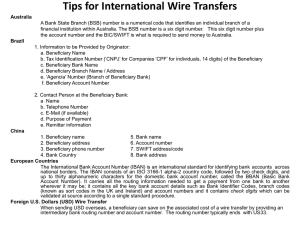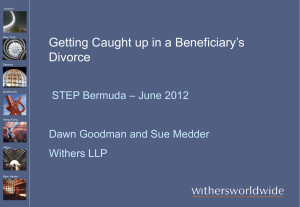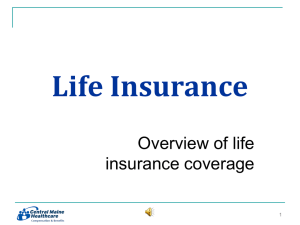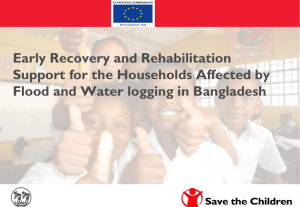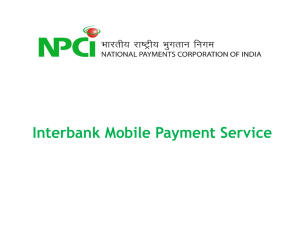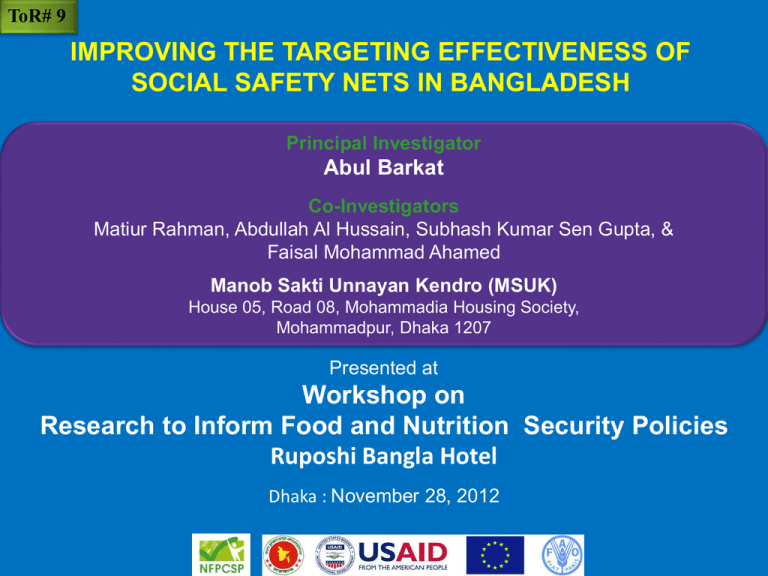
ToR# 9
IMPROVING THE TARGETING EFFECTIVENESS OF
SOCIAL SAFETY NETS IN BANGLADESH
Principal Investigator
Abul Barkat
Co-Investigators
Matiur Rahman, Abdullah Al Hussain, Subhash Kumar Sen Gupta, &
Faisal Mohammad Ahamed
Manob Sakti Unnayan Kendro (MSUK)
House 05, Road 08, Mohammadia Housing Society,
Mohammadpur, Dhaka 1207
Presented at
Workshop on
Research to Inform Food and Nutrition Security Policies
Ruposhi Bangla Hotel
Dhaka : November 28, 2012
Background and Objectives
Every 3rd household (31.5%; HIES 2010) live in poverty
Social safety net programmes (SSNP) have been mainstay of
poverty alleviation strategy since independence
Currently, 24.6% HHs (Rural 30.1% & Urban 9.4%) receive
SSNP benefit (HIES 2010), which was 13% in 2005
In FY 2012-13, Tk. 227.5 billion allocated under Social Protection
& Empowerment (11.87% of the budget & equivalent to 2.18% of
the GDP) (Social protection 75%; empowerment 25%)
Large amount of money spent on SSNP; number of beneficiaries increasing
Often questioned – whether most eligible persons receive SSNPs?
TARGETING ERROR (both inclusion and exclusion) is thought to be a
serious drawback to reach the food insecure and the poor, in addition to
capacity constraints (e.g., constrained budget)
2
Background and Objectives … contd..
Recent studies identified 4 potential sources of targeting errors:
1. Mismatch of geographical allocations of resources & poverty
rates
2. Use of improper targetting indicators
3. Even if design of SSN targeting mechanism is sound, political
economy & implementation issues at local level overrides it
4. Institutional issues at central level foster overlaps and gaps in
coverage
Such targeting errors reduce the resources available to support
poorest & most food insecure households. Therefore, objective of
Government’s spending on SSNPs not fulfilled effectively.
3
Background and Objectives … contd..
This research is expected to:
Provide a comprehensive review of SSNP targeting mechanism &
errors that will enable GoB to improve targeting so that it better
reaches the food insecure and the poor
Contribute to achieve major national goals of National Food Policy
(2006) & National Food Policy Plan of Action (2008-2015)
Objectives:
To map the major sources of targeting errors in social safety nets &
assess their relative contribution
To recommend ways to decrease inclusion & exclusion errors at the
programme-level based on experiences in Bangladesh and in South
Asia regions
To identify potential ways forward for building a SSN system in
Bangladesh
4
Methodology and Data Sources
As per ToR, Household Income and Expenditure Survey (HIES) was the major data
source to investigate into targeting performance (inclusion and exclusion errors) of
public SSNPs in general and by individual programmes in particular.
The methodology was designed assigning special emphasis on
analysis of relevant HIES data.
Preliminary investigation revealed that out of 30 public SSNPs
included in HIES 2010, more than 20 programmes have <100
samples (very negligible compared to their countrywide
beneficiaries).
(E.g., only 4 beneficiary HHs of Maternity Allowance programme included
in HIES whose national beneficiary is 88,000.)
To avoid representation problem, study methodology was
redesigned in consultation with TAT members & other experts at
FAO/NFPCSP.
5
Methodology and Data Sources …contd…
From HIES 2010 data: Analysis made aggregating all beneficiary HHs
of all 30 programmes (the term is “public safety net beneficiaries”)
together & then for each of the 8 programmes with more than 100
sample HHs.
Recent studies conducted by other organizations/individuals: For
the remaining programmes, we reviewed recent studies conducted by
other organizations/individuals & used their findings.
Consultation with experts: For the purpose of drawing inferences on
the remaining programmes, we consulted experts who have conducted
research on safety net targeting or worked in relevant sectors.
Primary data collection: Even after the above three exercises,
inferences on some programmes will not be possible. For those
programmes a survey will be conducted to obtain primary data from the
beneficiary and eligible non-beneficiary HHs.
6
Major Findings based on
Secondary Analysis of HIES 2010
7
The HIES 2010 and SSNP in Bangladesh
The HIES (2010) includes (Section 1 Part C) 30 social safety net programmes.
The respondent households (n=12,240) were asked 7 questions on safety net
programmes. The questions covered:
Whether the household (any member of the household) has been included in any SSNP in
the preceding 12 months
If “Yes”, which programme(s)
When s/he was included in the programme (month and year)
What benefit s/he is entitled to receive from the programme
What benefit (cash/kind) s/he has received
How much money s/he had to spend to be included in the programme
If “not included”, what was the reason for exclusion (both genuine and defects)
Other parts of HIES questionnaire include demographic & socioeconomic information
of household and members. The broad variables/indicators are:
Individual/Household level information available in the HIES 2010
Age, sex, marital status, religion/ethnicity, education and literacy, disability, illness and
injury, home, housing and basic service (water, sanitation and electricity), land ownership,
asset description
Earning status, employment status, income, economic activity (including agricultural,
livestock, fisheries etc), calamity and disaster, loan and remittance, household food and non8
food consumption
The HIES 2010 and SSNP in Bangladesh
Programme
Types
Social
Protection
Programmes
Social
Empowerment
Programmes
Total SSNP
Budget
Total public spending on SSNP
(FY 2012-13)
Total
Pension
Amount without
Amount (in Amount (in
Pension (in
billion Taka) billion Taka)
billion Taka)
Budgetary allocations
(for HIES-2010 Programmes)
% Total
Amount
% without
Pension
169.4
45.2
124.2
59.6
81.3
58.2
0
58.2
42.9
42.9
227.6
45.2
182.4
55.4
69.1
55% of the SSNP budget spent on programmes listed in HIES 2010;
Pension constitute 20% of SSNP budget (Is ‘Pension’ SSNP?)
Considering the 30 programmes listed in the HIES is a perfect sample for generalizations
about overall public safety net sector
9
SSNP Beneficiary Targeting
The first research issue is identification of targeting errors which can be
grouped as inclusion error—meaning inclusion of non-eligible & exclusion
error—meaning exclusion of eligible persons
We have compiled all the
eligibility (inclusion &
exclusion) criteria for most
of the selected public SSNPs
from relevant documents of
the respective programmes.
SSNP
Targeting of Beneficiary
Inclusion Criteria
Essential
Criteria
Exclusion Criteria
Priority
Criteria
Poverty—the most essential targeting criteria
‘Poverty’/’extreme poverty’/’poor household’ is an essential criterion for all the SSNPs
along with other criteria such as low income, landlessness, disability, gender, old age,
maternity & other vulnerability etc.
10
Household demography and
receipt of SSNP benefits
Nationally, households with 7-8 and 5-6 members are ahead of
other household sizes in terms of receipt of SSNP benefit.
Respectively 29% and 28% of beneficiary households are of
these sizes.
In rural areas, every 3rd beneficiary household consists of 1-2
members.
Nationally, 86% households are male headed & 14% female
headed. Of SSNP beneficiary households, 85% male headed
and 15% female headed.
A 30% household receive SSNP benefit where household head
is more than 60 years old.
11
SSNP Beneficiary HHs and land ownership status
Land ownership category
Landless
<15 decimals but not landless
15-49 decimals
50 decimals and more
Total
Frequency
190
1,541
452
806
2,989
Percent
6.4
51.6
15.1
27.0
100.0
Landlessness or HHs with less than 15 decimal of land is an essential/priority
criterion for SSNPs such as Old Age Allowance, Widow Allowance, Disability
Allowance, VGD, VGF, Maternal Voucher Scheme, Employment Generation
for Extreme Poor (former 100 Days EGP) etc
50 decimals
and more (%)
General Relief Activities
VGF
11.2
Programme Name
Programme Name
50 decimals and
more (%)
17.9
Widowed Allowance
15.1
Stipend for Primary Students
27.6
Gratuitous Relief
15.5
Stipend for Secondary Female Student
45.7
Old age Allowance
16.7
Agriculture Rehabilitation
58.0
12
Poverty, SSNP beneficiaries and literacy status
Respondent Type
All respondent of HIES
SSNP beneficiary Respondent
SSNP Non-beneficiary, below UPL*
Below UPL, all respondent
Below LPL, all respondent
Literacy Status
Literate
Illiterate
58.8
38.9
43.7
42.4
37.6
41.2
61.1
56.3
57.6
62.4
N
47,323
3,475
12,786
14,237
7,748
*Defined as eligible Non-beneficiary of SSNP
**This table is prepared for individuals. If a household is considered poor then all the members within
that HH are considered as poor.
***A person aged 7 years and above and who is able to write a letter is considered as literate in the HIES
Literacy status of beneficiaries of individual programmes (% literate):
Old age Allowance (13. 6)
Widowed Allowance (13.9)
Housing Support (20)
Test Relief (25)
Allowance for Insolvent Disabled (28.1)
VGF (28.5)
Cash for Work (29.4)
VGD (30)
Gratuitous Relief (36.4)
Open market sales (37.5)
Agriculture Rehabilitation (44.1),
13
Housing, sanitation, electricity and
availability of cell phone
• 21% have muddy wall and another 26% have walls made of hemp, hay, bamboo.
• 4% have roof made of mud, tally and wood while only 3% have concrete made
roof.
• Very negligible number of beneficiary households of the programmes designed
for the ultra poor or other vulnerable groups (e.g., old age allowance, widow
allowance, disability allowance, VGD, VGF, GR, TR, FFW etc) have walls or
roofs made of brick/cement.
• Only 11% beneficiary households have sanitary latrines.
• 39% beneficiary households have electricity connections at their residences.
Nationally, 55% HHs have electricity connections (rural 42.5%, urban 90%
• Regardless of programmes, more than half (51.1%) beneficiary households own
cell phone. Nationally, 64% households have cell phone.
• No data is available for individuals in the HIES.
14
Poverty, Income, Expenditure and
Social Safety Net
15
Poverty HCR and SSNP benefit flow
Division
National
Barisal
Chittagong
Dhaka
Khulna
Rajshahi
Rangpur
Sylhet
% of HH receiving SSNP Benefit
(Survey Year 2010)
Incidence of poverty (HCR) by
CBN Method (HIES 2010)
Total
Rural
Urban
Total
Rural
Urban
24.6
34.4
20.0
18.9
37.3
20.7
33.7
23.5
30.1
37.2
24.5
27.8
43.3
22.9
35.1
26.1
9.4
20.7
7.4
6.0
16.7
10.2
23.7
10.5
31.5
39.4
26.2
30.5
32.1
35.7
46.2
28.1
35.2
39.2
31.0
38.8
31.0
36.6
47.2
30.5
21.3
39.9
11.8
18.0
35.8
30.7
37.0
15.0
Regional disparity (improper allocation of resources) !!!
Highest % of HHs (37.3%) received benefit from SSNPs in Khulna
division. On the basis of poverty HCR, Khulna division ranks fourth
Poverty HCR is highest in Rangpur division (HCR 46.2% and 30.1% using
the Upper and the Lower poverty lines respectively), on the basis of SNP
beneficiaries, it ranks 3rd position with 33.7% beneficiary HHs
16
% distribution of beneficiary and non-beneficiary HHs by
income deciles and residence (rural-urban)
Household
Income
Deciles
National
Rural
Urban
National
Rural
Urban
Lower 5%
7.0
7.3
5.7
4.4
5.7
2.4
Decile-1
13.3
6.9
9.8
8.9
12.0
4.5
Decile-2
11.7
12.5
8.8
9.5
11.3
7.0
Decile-3
12.0
13.3
7.0
9.3
10.9
7.1
Decile-4
11.9
12.3
10.2
9.4
9.5
9.1
Decile-5
12.0
11.6
13.7
9.4
10.0
8.4
Decile-6
10.3
9.6
13.0
9.9
9.6
10.3
Decile-7
10.0
9.6
11.5
10.0
10.0
10.0
Decile-8
8.2
7.8
9.9
10.6
9.5
12.2
Decile-9
6.0
5.2
9.1
11.3
9.3
14.2
Decile-10
4.6
2.8
7.0
11.8
8.1
17.1
Top 5%
1.6
1.1
3.4
6.1
3.9
9.3
Total
100.0
100.0
100.0
100.0
100.0
100.0
N
2,989
2,374
615
9,251
5,466
3,785
SSN beneficiary households (%)
Non-beneficiary households (%)
17
% distribution of beneficiary HH of
major SSNPs by income deciles
Major Safety Net
Programmes (HIES
2010)
Old Age Allowance
Allowances for the
Widowed, Deserted and
Destitute Women
General Relief
Activities
Agriculture
Rehabilitation
Vulnerable Group
Feeding (VGF)
Gratuitous Relief (GR)Non-cash
Stipend for Primary
Students
Secondary and Higher
Secondary Stipend
Household Income Deciles (HIES 2010)
L5%
D1
D2
D3
D4
D5
D6
D7
D8
D9
D10
T5%
16.3
26.2 11.1
10.8
10.2
10.0
8.8
8.8
6.3
4.7
3.2
0.9
16.8
21.4 14.3
12.6
10.9
12.6
10.5
8.4
5.5
2.1
1.7
0.4
6.0
13.6 10.9
12.8
14.7
12.5
12.1
11.3
6.8
3.4
1.9
0.0
3.3
8.4
11.7
9.0
9.0
11.5
9.5
13.4
9.7
10.4
7.3
2.6
2.5
12.3 12.3
13.1
15.6
9.0
17.2
11.5
7.4
1.6
0.0
0.0
3.2
9.3
13.4
15.0
14.2
16.6
11.5
7.9
8.3
2.2
1.6
0.2
3.3
8.9
13.7
12.9
13.7
12.4
10.0
9.2
7.4
6.0
6.0
2.0
3.1
6.5
7.3
8.5
10.8
9.2
12.7
8.5
12.3 13.9 10.4
5.0
Only programmes with more than 100 beneficiary households in the HIES 2010 considered.
18
Are the HHs getting SSNP poor?
SSNPs are meant for the poor. In Bangladesh, 24.6% HHs
receive SSNP (where the poverty rate is 31.5%)
Given an ideal situation (i.e., safety net is for the poor), the above
figures seem satisfactory. However, the situation is not as ideal as
the figures appear. The reality is as below:
SSNP beneficiary HHs below Poverty Lines (HIES, 2010)
40.5
25.0
24.0
All
41.6
40.2
Rural
Below Upper Poverty Line
20.0
Urban
Below Lower Poverty Line
19
SSNP beneficiary households below Poverty Lines in
the CBN Method (by division and rural urban)
Divisions
National
Barisal
Chittagong
Dhaka
Khulna
Rajshahi
Rangpur
Sylhet
Location
Total
Rural
Urban
Total
Rural
Urban
Total
Rural
Urban
Total
Rural
Urban
Total
Rural
Urban
Total
Rural
Urban
Total
Rural
Urban
Total
Rural
Urban
Below Upper Poverty Line
40.5
40.2
41.6
47.3
43.9
61.3
36.2
36.8
33.8
41.8
42.3
40.1
41.2
39.5
48.3
30.5
28.6
37.7
47.8
50.3
38.9
31.4
33.5
14.3
Below Lower Poverty Line
24.0
25.1
20.0
31.1
30.0
35.5
19.4
19.5
18.8
24.4
26.9
16.6
20.3
20.6
19.3
17.9
17.9
18.0
32.0
34.2
24.4
24.7
27.8
0.0
% distribution of SSNP beneficiary HHs (8 major
SSNPs) by CBN poverty status, HIES 2010
Programme Name
HIES Sample
Household
Beneficiaries below
UPL
Frequency
%
Beneficiaries below
LPL
Frequency
%
Old Age Allowance
Allowances for the
Widowed,
Deserted and Destitute
Women
General Relief Activities
558
255
45.7
155
27.8
238
110
46.2
60
25.2
265
108
40.8
62
23.4
Agriculture Rehabilitation
Vulnerable Group Feeding
(VGF)
Gratuitous Relief (GR)Non-cash
Stipend for Primary
Students
Secondary and Higher
Secondary Stipend
546
148
26.4
78
13.9
122
53
43.4
27
22.1
494
246
49.8
151
30.6
599
306
51.6
201
33.6
260
73
28.1
42
16.2
21
Poverty and receipt of SSNP benefit
% distribution of HHs below UPL receiving SSNP benefit (HIES, 2010)
34.3
National
29.2
Sylhet
41.1
Rangpur
Rajshahi
19.7
46.3
Khulna
Dhaka
Chittagong
Barisal
30.4
31.7
44.2
22
Are these non-poor households
borderline poor?
Different poverty lines and per capita monthly expenditure of SSNP
beneficiary households (HIES 2010)
(Tk.)
Per capita expenditure of SSNP beneficiary
HHs
Lowest LPL (Khulna Rural)
Highest LPL (Ctg Urban)
Lowest UPL (Sylhet Rural)
Highest UPL (Dhaka SMA)
1997
1192
1495
1311
2038
23
Are these non-poor households borderline poor?
Per capita expenditure of
SSNP beneficiary HHs
Per capita expenditure of
poor (UPL)
Rural
Urban
1064
1133
1056
1246
1458
1200
1997
1931
2573
Per capita expenditure of poor HHs and SSN beneficiary HHs
Per capita expenditure of
poor (LPL)
All
24
Poverty status of SSNP beneficiaries with and
without SSNP benefit amount
Over 60% beneficiaries received ≤ Tk.100 from their respective SSNP in a month;
33% received between Tk.100 and Tk.300, and only 4% received between Tk. 301
and Tk.500. What happens if the amount is deducted from the HH income?
42.6%
40.5%
26.6%
20.4%
Benefit amount included in income
Poverty Status Below UPL
Benefit amount deducted from income
Poverty Status Below LPL
If SSNP benefit is deducted from the income of the beneficiary households,
poverty rate increases by only 2 percentage points
25
Poverty Status of beneficiary household (without the
benefit amount) by shifted Upper poverty line
Upper Poverty Line Shifted
72.0%
76.7%
66.2%
59.3%
50.7%
10% above
20% above
30% above
40% above
50% above
% of Poor HH
26
% of Benefit Received by Beneficiary Households
49.0% 51.0%
16.4%
18.4%
6.8%
Income Decile 1
All Programmes
6.7%
Income Decile 10
Combining Lowest
4 deciles
Excluding the Stipend Programmes
27
% of food expenditure in consumption
expenditure
• 79% of all households spend
more than half of their
consumption expenditure in food.
% HH spending more than half of its
consumption expenditure in food
92.2
• Rate is highest (92.2%) in lowest
income decile.
• Rate is lowest (44.7%) in top
income decile.
78.8
44.7
• Distribution by consumption
expenditure deciles provide
similar result.
Income Decile 1 Income Decile 10
All HH
28
% of food expenditure in consumption expenditure
by different type of Household
% HHs spending more than half of its consumption expenditure in
food consumption
87.2
95.2
96.0
78.8
All HH
SSNP Beneficiary
HH Below UPL
HH Below LPL
29
Targeting errors in certain SSNPs using programme
specific eligibility criteria (HIES 2010)
Programmes & Criteria
1
Old age allowance:
Minimum age criteria (male 65 years, female 62 years)
Annual Income of beneficiary (less than Taka 3000)
Beneficiary is from a landless household
Beneficiary of other Public/NGO SSNP
More than one beneficiary from the same Household
2
Allowance for the Widowed Deserted and Destitute
Female is a Widow/ Deserted by Husband /Destitute
Annual income <12000 Tk.
Beneficiary of other Public/NGO SSNP
3
General Relief Activities
Household Affected by Natural Disaster
Household below Lower poverty Line (CBN)
Landless/Less than 10 decimal of land
Note: Certain indicators are not available in the HIES
Error Found (%)
35.2 and 35.6
99.5
19.4
12.4
1.8
25.2
32.4
6.3
84.9
76.6
50.2
30
Targeting errors in certain SSNPs using programme
specific eligibility criteria (HIES 2010)
Programmes & Criteria
Error Found (%)
4
Vulnerable Group Feeding (VGF) programme
Landless/Having Less than .15 acres of land
36.9
Female Household head
84.4
Household affected by Natural Calamity
87.7
Multiple Beneficiary from same Household
0.8
Beneficiary of other Public/NGO SSNP
4.9
5
Gratuitous Relief-Non-cash
Household Affected by Natural Disaster
88.9
Annual income of Beneficiary <3000 Tk.
99.6
Household below Lower poverty Line (CBN)
69.4
Landless/Have Less than 10 decimal of land
45.6
6
Stipend for Secondary and Higher Secondary Female Students
Total monthly Household income<2500 Taka
95.4
Landless/Owning less than .50 acres
44.6
Note: Certain indicators are not available in the HIES
31
On leakage and targeting error in SSNP
in the Sixth Five Year Plan
The Sixth Five Year Plan of the country states coverage issues, targeting
beneficiaries, leakages, and disparity in regional distribution etc as the key
challenges of implementing SSNPs are. Some of the highlights are as follows:
While coverage is relatively low, a significant number of HHs gain
access to multiple SSNPs. A quarter of HHs were receiving transfers
from more than one SSNP.
Over 11% households were participating in at least two of the three
programs – VGD, FFE and FFW. Coverage in urban areas remains low.
27% VGD beneficiaries are not poor.
11% participants of PESP meet none of the eligibility criteria; almost
none of the beneficiaries meet at least three criteria. Almost 47% PESP
beneficiaries are non-poor and incorrectly included in program.
All HHs within less-poor Upazila are denied assistance, including those
with very high food insecurity.
32
On leakage and targeting error in SSNP
in the Sixth Five Year Plan…..contd.
Leakage in FFW program is 26%.
Leakage in female stipend programs 10%-12%.
About 20%-40% budgetary allocations for female secondary
stipend program do not reach beneficiaries.
Leakages show a strong correlation with number of intermediaries
in the transfer process.
HIES 2005 showed regional disparity in distribution of
households receiving social protection benefits. Barisal and
Rajshahi divisions, with the highest incidence of poverty, did not
have the correspondingly higher number of social protection
beneficiaries. In contrast, Sylhet Division, with the second lowest
poverty incidence had the highest proportion of social protection
recipients.
33
Concluding observations
Coverage & budgetary allocation in SSNP sector – increasing
every year
Every 4th HH is covered by SSNP (HIES 2010)
The declining trend of poverty over the years at a rate of 1.7%
justifies Government’s spending on SSNP.
No concrete evidence that government’s spending on SSNP is
being received by the poor and hence poverty is declining.
Large number of beneficiary HHs of major SSNPs are not poor at
least in terms of official measures of poverty.
However, it is also not true that the benefits are being captured by
the elites since most beneficiaries are from the lower income
deciles.
False prioritization (high inclusion error) exists.
34
Concluding observations
The number of targeting criteria for the existing SSNPs are huge.
Some are obsolete and sometimes impractical. (e.g., annual
income <Tk.3,000 for Old Age Allowance is quite absurd). Such
criteria should be revisited.
The term ‘insolvent’ is used as an eligibility criterion for many
SSNPs. However, it is not properly defined in any of the
document. A working definition for this term is necessary.
The term ‘poverty’ is used for most SSNP as an eligibility
criterion. However, government's definition of poverty does not
seem to match with that of implementation authority. `poverty’
criterion should be administrable.
35
We welcome your valuable comments and
suggestions for the improvement of the study
Thank
You
36
Backup Slides
37
HIES (2010) and SSNP
Programmes
Old Age Allowance
Allowances for the Widowed, Deserted and Destitute
Women
Allowances for the Financially Insolvent Disabled
Maternity allowance programme for the Poor Lactating
Mothers
Honorarium for Insolvent Freedom Fighters
Honorarium for Injured Freedom Fighters
Gratuitous Relief (GR)- Cash
General Relief Activities
Allowances for Distressed Cultural Personalities/Activists
Food Assistance in CTG-Hill Tracts Area
Stipend for Disabled Students
Grants for the Schools of disabled
Cash for Work
Housing Support
Agriculture Rehabilitation
Open Market Sales (OMS)
Beneficiaries
(Nationally)
2475000
Beneficiaries in the
HIES 2010
558
920000
238
286000
32
88000
4
150000
8000
8000000
500000
1000
714000 (Man Month)
19000
12000
3810000 (Man Month)
100000
2500000
13800000 (Man Month)
16
14
54
265
0
14
9
0
16
5
546
6
38
HIES (2010) and SSNP
Programmes
Beneficiaries (Nationally)
Vulnerable Group Development (VGD)
Vulnerable Group Feeding (VGF)
Test Relief (TR) Food
Gratuitous Relief (GR)- Non-cash
Food For Work (FFW)
100 days Employment Scheme/ Employment
Generation Programme for the Hardcore Poor
Stipend for Primary Students
School Feeding Programme
Stipend for Dropout Students
Stipend and Access Increase for Secondary
and Higher Secondary Level Students
(including Proposed Secondary Education
Stipend Project)
Maternal Health Voucher Allowance
Rural Employment Opportunity for Public
Asset
Char Livelihood Programmes
Rural Employment and Rural Maintenance
Programme
Total (Beneficiary Households)
8833000
12222000 (Man Month)
3905000 (Man Month)
8000000 (Man Month)
3810000 (Man Month)
Beneficiaries in the HIES
2010
10
122
132
494
4
4200000
20
7800000
315000
350000
599
6
34
3600000
260
180000
5
25000
2
55000
9
46000
5
---
2989
39
Status of poor HHS getting SSNP benefit
(HIES 2010)
37.7
34.2
% HHs below UPL received
SSNP benefit
% HHs below LPL received
SSNP benefit
40
Performance assessment using
programme specific variables
Targeting Efficiency of Old Age Allowance
Targeting/Eligibility Criteria
Inclusion Criteria (Essential)
Age >65 years (Male)
Age >62 years (Female)
Annual income of Beneficiary <3000 Tk.
Beneficiary from a Landless HH
Beneficiary is Physically Infirm
Beneficiary is handicapped
Exclusion Criteria
Beneficiary is a Government Service Holder
Beneficiary is a Pension Recipient
Beneficiary is a VGD Card Holder Women
Beneficiary of other Public/NGO SSNP
More than one beneficiary from the same
Household
Beneficiary is a Day laborer/Maidservant/Vagrant
** Certain indicators are not available in the HIES
No. Beneficiaries
included in the
HIES-2010
No. of
beneficiary not
% of Error
satisfying the
criteria
276
292
558
558
-
97
104
555
108
-
35.2
35.6
99.5
19.4
-
558
558
558
0
69
10
0.0
12.4
1.8
-
-
41
Performance assessment using
programme specific variables
Targeting Efficiency of Widow Allowance
Targeting/Eligibility Criteria
No.
No. of
Beneficiaries beneficiary
included in the not satisfying
HIES-2010
the criteria
Inclusion Criteria (Essential)
Female is a Widow/Husband’s
238
Deserted/Distitute
Annual income <12,000 Tk
238
Exclusion Criteria
Beneficiary is a Government Service
Holder
Beneficiary is a Pension Recipient
Beneficiary is a VGD Card Holder
238
Women
Beneficiary of other Public/NGO SSNP
238
** Certain indicators are not available in the HIES
% of
Error
60
25.2
77
32.4
-
-
-
-
0
0.0
15
6.3
42
Performance assessment using
programme specific variables
Targeting Efficiency of Targeting Efficiency of General Relief Activities
Targeting/Eligibility Criteria
No. Beneficiary
No. of
household
beneficiary not
included in the satisfying the
HIES-2010
criteria
% of
Error
Household Affected by Natural
Disaster
265
225
84.9
Household below Lower poverty
Line (CBN)
265
203
76.6
Landless/Less than 10 decimal of
land
265
133
50.2
43
Performance assessment using
programme specific variables
Targeting Efficiency of Vulnerable Group Feeding (VGF)
Targeting/Eligibility/Exclusion
Criteria
No. Beneficiary
No. of
household
beneficiary not
included in the
satisfying the
HIES-2010
criteria
Inclusion Criteria (Essential)
The recipient is a Day laborer
122
Landless/Having Less than 0.15 acres
122
of land
Female Household head
122
Household affected by Natural
122
Calamity
Exclusion Criteria
Multiple Beneficiary from same
122
Household
Beneficiary of other Public/NGO
122
SSNP
** Certain indicators are not available in the HIES
% of
Error
-
-
45
36.9
103
84.4
107
87.7
1
0.8
6
4.9
44
Performance assessment using
programme specific variables
Targeting Efficiency of Gratuitous Relief-Non-cash
Targeting/Eligibility
Criteria
Household Affected by
Natural Disaster
Annual income of
Beneficiary <3000 Tk.
Household below Lower
poverty Line (CBN)
Landless/Have Less than
10 decimal of land
No. Beneficiary
No. of
household
beneficiary not % of
included in the satisfying the Error
HIES-2010
criteria
494
439
88.9
494
492
99.6
494
343
69.4
494
225
45.6
45
Performance assessment using
programme specific variables
Targeting Efficiency of Stipend for Secondary and Higher
Secondary/ Female Student
Targeting/Eligibility Criteria
No. Beneficiary
No. of
household
beneficiary not
included in the satisfying the
HIES-2010
criteria
Total monthly Household
260
income<2500 Taka
Landless/Owning less than .50 acres
260
Household headed by person with
260
disabilities or incapable to earn
HH Head is a Wage Laborer or
260
Rickshaw Puller
** Certain indicators are not available in the HIES
% of
Error
248
95.4
116
44.6
46
Poverty and SSNP beneficiary HHs
(except 2 stipend)
Percentage distribution of the SSNP beneficiary HHs (except 2 stipend
programmes) by poverty status in the CBN method, HIES 2010
Divisions
Barisal
Chittagong
Dhaka
Khulna
Rajshahi
Rangpur
Sylhet
Total
(All SSNPs)
% of beneficiary HHS below
UPL
43.6
36.8
41.8
42.9
31.9
47.8
33.1
40.5
40.5
% of beneficiary HHS
below LPL
26.4
18.1
24.4
21.1
18.5
32.2
25.8
23.4
24.0
47
Reported reasons for exclusion
Distribution of the reported reasons for not being included in major Public SSNPs
Cause of Not being Included in a
Frequency Percent
Programme
Beneficiary Recipients (individual)
3,508
6.3
Not Applicable (HH members age <5
years)
5,630
10.1
Did not know about the programme
2,045
3.7
Not eligible for the programme
29,939
53.9
Eligible for the programme but did not
apply
1,853
3.3
Due to budget constraints
1,769
3.2
Selection was not proper
9,975
17.9
No programme in this area
861
1.5
Total
55,580
100
Cumulative
Percent
6.3
16.4
20.1
74.0
77.3
80.5
98.5
100
48
Multiple beneficiary recipient
Status of multiple beneficiary recipient Households in HIES 2010
No. of benefits received
Frequency
by HHs
Percent
Cumulative
Percent
1
2,555
85.5
85.5
2
366
12.2
97.7
3
55
1.8
99.6
4
9
0.3
99.9
5
4
0.1
100
Total Beneficiary HHs
2,989
100
49
Key Research questions by Broad Scopes
The 12 month long research project will make efforts to answer the
following research questions at the end of the study:
Scope 1: Targeting of Social Safety Nets in Bangladesh
1. What are the main characteristics of the targeting process (targeting
mechanism) of selected public safety net programmes (SSNP) in
Bangladesh?
2. How effective is the targeting performance (outreach to the poorest) of the
major public SSNPs?
3. What targeting mechanisms are adopted in the large NGO safety net
programmes of the country?
Scope 2: Inclusion and Exclusion Errors
1. Who are the excluded households from public SSNPs (in relation to
poverty, location, gender and age of head, dependency ratio, and data
permitting, food security and nutrition status)?
2. What are public SSNPs that the food-insecure households access?
3. What are the inclusion errors of public safety net programmes?
4. What are the factors accounting for errors in different regions, programs
and targeting methodologies?
50
Key Research questions by Broad Scopes
Scope 3: Addressing Errors
1. What are the challenges faced by major SSNPs to address inclusion
and exclusion errors in Bangladesh and in the South Asia region?
2. What are the good practices in certain SSNPs that can be used to
address inclusion and exclusion errors in Bangladesh and in the
South Asia region for major safety net programmes?
3. What are complementarities between geographical, household-level
and community-based targeting of SSNPs?
4. What potential roles can information technology play to improve
targeting outcomes?
5. What roles can grievances and accountability measures play to
improve targeting outcomes given existing administrative and
political capacities?
6. What are the effective/successful mechanisms adopted by NGO
programs that can be adjusted/scaled-up to government-run
programmes?
51
Key Research questions by Broad Scopes
Scope 4: Effective Targeting in Bangladesh
1. What are the options for improving the effectiveness of
targeting, in particular decreasing exclusion errors, in
Bangladesh?
2. What are the institutional issues of coordination between
programmes at the local level and line ministries at the
central level?
3. What is the relevance and feasibility of a nationwide
targeting/identification system of SSNPs, with a
potential road map?
52
Seri
al
Matrix: Safety Net programmes considered for the proposed survey
1
2
3
Programmes
Old Age Allowance
Allowances for the
Widowed, Deserted and
Destitute Women
Allowances for the
Financially Insolvent
Disabled
Programme Type
Included/excluded in the
proposed survey
Reason for inclusion/exclusion
Regular cash
transfer
included
Number of total beneficiaries is large
Lists of beneficiaries by Ward available at the UP
Level
Waiting list is also available
Regular cash
transfer
included
Number of total beneficiaries is large
list of beneficiaries available at the UP Level
Regular cash
transfer
Included but maybe dropped
if sufficient sample not
available at PSU level
Small programme but important because it benefits a
particular vulnerable group
Included but maybe dropped
if sufficient sample not
available at PSU level
Number of beneficiaries is low, will require specific
selection of respondent in the selection area (if
beneficiaries exist), on average at least one beneficiary
will exist in a village but this may not be the reality, not
possible to select specific area for this kind of
beneficiary
4
Maternity allowance
programme for the Poor
Lactating Mothers
Fixed duration (2
years cycle) cash
transfer
5
Honorarium for Insolvent
Freedom Fighters
Regular cash
transfer
excluded
Although number of total beneficiaries is moderate,
they are not distributed equally in the PSU
Does not address poor people in general
6
Honorarium for Injured
Freedom Fighters
Regular cash
transfer
excluded
Small programme
Does not address poor people in general
7
Gratuitous Relief (GR)Cash & Food
Relief Activities
included
Number of total beneficiaries is large
Easy to find with random selection at the field level
Relief Activities
Included but maybe dropped
if beneficiaries cannot be
identified during survey
Number of total beneficiaries is large
8
General Relief Activities
53
Matrix: Safety Net programmes considered for the proposed survey
Sl
9
10
Programmes
Allowances for Distressed
Cultural
Personalities/Activists
Food Assistance in CTGHill Tracts Area
Programme Type
Cash Transfer
Included/excluded in
the proposed survey
excluded
Food Security
excluded
11
Stipend for Disabled
Students
Stipend (regular)
Included but maybe
dropped if sufficient
sample not available at
PSU level
12
Grants for the Schools of
disabled
Institutional grant
excluded
13
Food/Cash for Work
Works Programme included
14
Housing Support
Relief Activities &
Disaster
excluded
Management
15
Agriculture Rehabilitation
Seasonal
included
16
Open Market Sales (OMS)
Food transfer at
lower price
excluded
Reason for inclusion/exclusion
Number of total beneficiaries is very small
Will require purposive selection if list exist
Area Specific Programme
Random Selection of areas may prove to be a ‘not so
good’ option
Will need specific sampling or selection of area
Number of Beneficiaries is small, may require purposive
sample selection, random selection of respondents in the
sampling area may exclude the beneficiaries within the
selected area
Household interviewing may not be a option to collect
information
Large programme
Easy to find with random selection at the field level,
List of beneficiaries exist
Small programme
Beneficiaries are not distributed equally in the PSU
Area specific programme
Large programme
Easy to find with random selection at the field level
But it does not include the poor/vulnerable people
Although OMS is a large programme, it has no fixed
beneficiary
Identification of beneficiary is not possible during survey
54
Matrix: Safety Net programmes considered for the proposed survey
Sl
Programmes
Vulnerable Group
Development (VGD)
Vulnerable Group Feeding
18
(VGF)
19 Test Relief (TR) Food
100 days Employment
Scheme/ Employment
20
Generation Programme for
the Hardcore Poor
17
Programme Type
Included/excluded in
the proposed survey
Food Security
included
Food Security
included
Relief Activities
excluded
Works Programme included
21 Stipend for Primary Students Stipend (regular)
included
Tiffin for school
students
excluded
Stipend for Dropout Students
23 (may be considered for
Stipend (regular)
selection)
excluded
Stipend and Access Increase
for Secondary and Higher
Secondary Level Students
24
Stipend (regular)
(including Proposed
Secondary Education Stipend
Project)
included
22 School Feeding Programme
Reason for inclusion/exclusion
Number of total beneficiaries is large
Easy to find with random selection at the field level
Number of total beneficiaries is large
Easy to find with random selection at the field level
Programme does not benefit individuals directly
Number of total beneficiaries is large
Easy to find with random selection at the field level
Number of total beneficiaries is large
Easy to find with random selection at the field level
Area specific programme
Will require purposive area selection
Poverty is not a selection criteria for the beneficiary (all
the students in a school receive the benefit irrespective of
poverty status)
Small programme; Number of beneficiaries is very
smaller than other stipend programmes (primary and
secondary level stipend programmes),
not possible to select specific area for this kind of
beneficiary,
will require purposive section of beneficiary
Number of total beneficiaries is large
easy to find with random selection at the field level
55
Matrix: Safety Net programmes considered for the proposed survey
Sl
Programmes
Programme Type
Single time
benefit
Included/excluded in the
proposed survey
25
Maternal Health Voucher
Allowance
26
Rural Employment
Works Programme excluded
Opportunity for Public Asset
excluded
27 Char Livelihood
Seasonal
excluded
Rural Employment and
28 Rural Maintenance
Programme (RERMP)
Included but maybe dropped
Works Programme if sufficient sample not
available at PSU level
Reason for inclusion/exclusion
Very small programme
will require specific selection of respondent in the
selection area (if beneficiaries exist), not possible to
select specific area for this kind of beneficiary
Small and area specific programme
Area Specific Programme
Random Selection of areas may prove to be a ‘not so
good’ option, will need specific area sampling.
Small programme but very much poverty focused
56
Average duration of SSNP benefit receiving
for major regular SSNPs
Average
Duration (month)
Average
Duration (year)
45.6
3.8
44.6
3.7
25.4
2.1
25
2.1
Honorarium for Freedom Fighters*
53.5
4.5
Allowances for the Financially Insolvent
Disabled
44.6
3.7
Programme Name
Old age allowance
Allowance for Widowed, Deserted and
Destitute Women
Stipend for Secondary and Higher Secondary
Level Students
Stipend for Primary Students
*Aggregating the ‘Honorarium for Injured Freedom Fighters’ and ‘Honorarium for Insolvent Freedom Fighters’ together
Note: The HIES 2010 survey ended in January 2011. These duration estimates are made as of January 2011.
The HIES did not ask the households whether any member received SSNP benefit in the lifetime. It only
57
focused the current situation. The proposed survey may consider this issue.
HH size and residence (rural-urban)
HH Size
National
Rural
Urban
All size
24.4
30.3
14.0
1-2
26.6
33.6
12.9
3-4
20.6
27.3
10.2
5-6
28.1
32.9
18.8
7-8
28.6
32.8
19.6
9-10
20.3
24.5
12.7
11+
22.7
25.0
17.1
58
Age of HH head & residence (rural-urban)
Age of Head of
HH
National
Rural
Urban
All Age
24.4
30.3
14.0
<=29
17.4
21.4
9.6
30-39
22.1
28.3
11.5
40-49
25.4
32.2
14.7
50-59
24.6
30.4
15.0
60+
30.0
35.0
18.3
59
Gender, Marital Status, religion and residence
(rural-urban)
HHs receiving SSNP (%) N=2989
HH
Characteristics
National
Rural
Urban
National
24.4
30.3
14.0
Gender of Household Head
Male
24.3
30.3
13.8
Female
25.3
30.2
14.9
Marital Status (of household Head)
Married
23.5
29.2
13.6
Unmarried
27.3
34.3
14.6
Widowed/divorced
33.0
39.8
18.0
Religion
Muslim
24.0
29.6
14.2
Non-Muslim
27.2
34.8
12.2
60
Beneficiary HHs by land ownership and
residence
HHs receiving SSNP (%) N=2,989
Size of Land
Holding (acres)
National
Rural
Urban
All size
24.4
30.3
14.0
No Land
17.9
33.1
9.7
<0.05
19.2
26.5
11.9
0.05-0.49
25.7
31.7
15.0
0.50-1.49
29.7
31.8
18.8
1.50-2.49
32.1
31.6
35.6
2.50-7.49
29.2
29.8
25.0
7.50+
20.6
20.7
20.0
61
Beneficiary HHs by land ownership categories
Programme Name
Stipend for Primary
Students
Old age Allowance
Landless
15 Decimals and 15> Decimals but < 50 Decimals
Less (not landless)
50 Decimals
and more
N
4.1
49.5
18.7
27.6
630
6.7
59.2
17.4
16.7
568
Agriculture Rehabilitation
1.4
20.5
20.0
58.0
560
Gratuitous Relief
6.0
64.2
14.3
15.5
503
General Relief Activities
11.9
59.7
17.3
11.2
278
Stipend for Secondary
Female Student
3.2
34.5
16.6
45.7
278
Widowed Allowance
8.0
60.1
16.8
15.1
238
VGF
12.2
59.4
10.6
17.9
123
62
Chi-Square scores for categories of different
demographic characteristics
It is evident that there is statistically significant difference in the safety
net receiving in the urban and rural areas at 1% level of significance.
The different household size is also significant at 1% level of
significance for safety net receiving as well as the land ownership
categories and age of the head of the household. However, there is no
statistically significant difference in the safety net receiving by the sex
of the household head at 5% level of significance which is also true for
religious identity of the household.
It is also found that there is statistically significant difference in the
poverty status (both UPL and LPL) in urban and rural areas at 1% level
of significance. The different household size is also significant at 1%
level of significance for poverty status (both UPL and LPL) as well as
the land ownership categories and age of the head of the household.
There is no statistically significant difference in the poverty status (for
LPL) by the sex of the household head at 5% level of significance
which is also true for religious identity of the household.
63
Chi-Square scores for categories of different
demographic characteristics
Demographic
Characteristics
Chi-Square Scores
SSNP beneficiary
Poverty Status
status
based on UPL
Poverty Status
based on LPL
Urban-Rural
405.9
82.4
151.0
Household Size
87.6
415.6
327.9
Land Ownership
103.4
316.1
225.3
Age of HH Head
83.6
117.9
78.6
Sex of HH Head
0.9
25.1
6.6
Marital Status of HH
Head
50.5
6.3
10.9
3. 390
3.7
5.7
Religious Status of HH
64
SSNP beneficiaries and their literacy status
Programmes
Stipend for Primary Students
Old age Allowance
Agriculture Rehabilitation
Gratuitous Relief
General Relief Activities
Stipend for Secondary Female Student
Widowed Allowance
VGF
Literacy Status
Literate
Illiterate
54.3
45.7
13.6
86.4
44.1
55.9
28.6
71.4
33.1
66.9
99.6
0.4
13.9
86.1
28.5
71.5
N
630
568
560
503
278
278
238
123
65
Housing and Sanitation Condition of SSNP
beneficiary HHs
Material of Wall
F
%
Brick/cement
368
12.3
C.I. Sheet/wood
Mud brick
Hemp/hay/bamboo
Other
Total
1210
622
767
22
2989
40.5
20.8
25.7
0.7
100
Latrine type
Sanitary
Pacca latrine (water seal)
Pacca latrine (pit)
Kacha latrine (perm)
Kacha latrine (temp)
Other
Total
Material of Roof
Concrete
(brick/cement/rod)
C.I. Sheet/wood
Mud/tally/wood
Hemp/hay/bamboo
Other
Total
Frequency
342
377
490
894
719
167
2989
F
%
97
3.2
2505
112
235
40
2989
83.8
3.7
7.9
1.3
100
Percent
11.4
12.6
16.4
29.9
24.1
5.6
100
66
HH electrification status of SSNP
beneficiaries
Electricity & Cell Phone
SSNP beneficiary HHs with electricity in their house
F
%
1164
38.9
Beneficiary HHs have cell phone
1525
51.1
N
2989
100.0
Nationally 55.26% of the HHs has electricity connections (Rural 42.49%,
Urban 90.10%
67
Incidence of poverty (HCR) by CBN method
by division (HIES 2010 and 2005)
Poverty Line and
Division
Total
2010
Rural Urban
Using the Upper Poverty Line
National
31.5
35.2
Barisal
39.4
39.2
Chittagong
26.2
31.0
Dhaka
30.5
38.8
Khulna
32.1
31.0
Rajshahi (Former)
35.7
36.6
Rajshahi (New)
29.8
30.0
Rangpur
46.2
47.2
Sylhet
28.1
30.5
21.3
39.9
11.8
18.0
35.8
30.7
29.0
37.0
15.0
Total
2005
Rural
Urban
40.0
52.0
34.0
32.0
45.7
51.2
33.8
43.8
54.1
36.0
39.0
46.5
52.3
36.1
28.4
40.4
27.8
20.2
43.2
45.2
18.6
68
Per Capita monthly expenditure of the poor
by residence and divisions (Taka)
Per Capita expenditure of the Poor
Division
Using Lower Poverty Line
Using Upper Poverty Line
Total
Rural
Urban
Total
Rural
Urban
National
1064.9
1056.0
1133.4
1245.8
1200.0
1457.7
Barisal
1044.7
1031.4
1119.9
1176.0
1140.9
1348.8
Chittagong
1174.5
1169.8
1231.9
1381.8
1361.7
1540.6
Dhaka
1071.3
1060.2
1174.8
1290.9
1192.6
1610.2
Khulna
1018.1
984.1
1124.3
1212.6
1170.0
1337.5
Rajshahi
1041.1
1034.8
1074.3
1205.2
1186.8
1280.7
Rangpur
1027.1
1019.7
1109.3
1150.2
1140.8
1247.8
Sylhet
1049.4
1051.0
1013.2
1117.0
1102.6
1276.9
2010
69
% distribution of beneficiary and non-beneficiary HHs by
consumption expenditure deciles and residence (rural-urban)
Expenditure
Deciles
Lower 5%
Decile-1
Decile-2
Decile-3
Decile-4
Decile-5
Decile-6
Decile-7
Decile-8
Decile-9
Decile-10
Top 5%
Total/Deciles
N
SSN beneficiary households (%)
Non-beneficiary households (%)
National
8.8
15.0
12.4
11.2
11.6
11.4
10.5
9.1
7.7
6.5
4.7
1.9
100.0
2,989
National
3.8
8.4
9.2
9.6
9.5
9.6
9.8
10.3
10.8
11.1
11.7
6.0
100.0
9,251
Rural
9.6
16.6
12.7
12.0
11.8
11.5
10.9
9.2
6.9
5.2
3.3
1.1
100.0
2,374
Urban
5.9
8.8
11.1
8.3
10.7
10.7
9.3
8.9
10.7
11.4
10.1
5.0
100.0
615
Rural
5.0
10.9
10.8
11.0
10.8
10.4
10.5
10.0
10.1
8.8
6.8
3.2
100.0
5,466
Urban
1.9
4.8
7.0
7.6
7.6
8.3
8.9
10.7
11.7
14.6
18.8
10.0
100.0
3,785
% distribution of beneficiary HHs of major SSNPs by
consumption expenditure deciles
T5%
0.9
0.4
1.1
3.5
0.0
0.6
1.7
D10
1.4
1.7
3.8
8.6
0.0
1.2
71
5.0
6.0
15.0
3.8
8.7
11.5
Only programmes with more than 100 beneficiary households in the HIES 2010 considered.
14.2
D9
6.1
2.9
5.7
9.2
0.8
10.4
13.9
4.3
D8
4.7
5.9
7.9
11.7
6.6
10.5
10.0
5.9
D7
7.9
6.3
9.8
10.6
10.7
10.9
8.1
6.7
D6
10.4
8.8
10.2
12.3
11.5
14.5
10.8
9.5
D5
10.6
9.7
15.1
12.1
10.7
12.2
7.3
12.4
D4
10.0
8.0
10.2
11.4
16.4
15.2
5.8
13.0
D3
7.5
13.0
12.5
9.7
10.7
7.9
Secondary and Higher Secondary Stipend
3.5
14.6
D2
12.2
17.7
10.2
7.7
18.0
2.2
15.8
D1
28.3
26.1
14.7
6.8
20.3
16.8
Stipend for Primary Students
1.2
Gratuitous Relief (GR)- Non-cash
14.8
Vulnerable Group Feeding (VGF)
16.8
Agriculture Rehabilitation
10.2
General Relief Activities
1.8
Allowances for the Widowed, Deserted and Destitute
Women
6.6
Old Age Allowance
9.1
Major Safety Net Programmes (HIES 2010)
L5%
Household Income Deciles (HIES 2010)
71
Estimating the Monthly benefit amount
received by SSNP beneficiaries
• Beneficiaries of Safety Net Programmes with Regular
Monthly Allowance (in taka) are assumed to receive the
fixed amount every month.
• For the benefits that are given in kind, the money value is
estimated.
• In order to convert the kind benefits to equivalent money
value, the per kg value of kind (rice, wheat etc.) is estimated
from HIES 2010 data.
• Benefit that are received once in a year, is divided by 12 to
find out the average amount of benefit received in a month.
72





